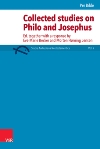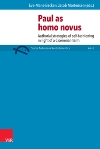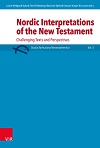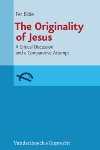| Buchhandlung Heesen | Versandbuchhandlung für Evangelische Theologie |
Impressum | |
| Freudenstadt / Loßburg | Datenschutzhinweise | ||
| Tel. 07446 952 418 1 | Buchhandlung.Heesen@t-online.de | ||
| Da unsere Angebote manuell erstellt werden und während des Seitenaufrufes keine Verbindung zu einer Buchdatenbank aufgebaut wird prüfen wir die Verkaufspreise bei Rechnungsstellung auf Richtigkeit und berechnen den gesetzlich festgelegten Buchpreis. Falls sich dadurch eine Preiserhöhung ergibt werden wir Sie vor Versand informieren, Sie können dann diesem Preis zustimmen oder vom Kauf zurücktreten. Hinweise zum Datenschutz und Cookies | |||
| Studia Aarhusiana Neotestamentica (SANt) |
| Die Reihe Studia Aarhusiana Neotestamentica wendet sich an alle, die im Bereich von Theologie, Bibelwissenschaften, Religionswissenschaften, Patristik, Judaistik und Klassischer Philologie forschen und lehren: Sie betrachtet das „Neue Testament“ als frühchristliches Textcorpus, das sowohl in Hinsicht auf seine entstehungsgeschichtliche Kontextualisierung in der Hellenistisch-Römischen und -Jüdischen Welt als auch im Blick auf seine enorme Wirkungs- und Rezeptionsgeschichte über die patristische Zeit hinaus bis in die Moderne methodisch und thematisch vielfältig zu untersuchen ist. Das neutestamentliche Textcorpus erweist sich hiermit gleichsam als Brennglas für das Verstehen der abendländischen und inzwischen weit über das Abendland hinausreichenden Prozesse von religiöser und kultureller Formation, Reformation und Transformation. Die Reihe wird von den Dozenten, die in der Forschungseinheit „New Testament Studies“ an der Universität Aarhus zusammenarbeiten, herausgegeben. Sie versteht ihre geographische Verankerung als Teil wissenschaftlicher Programmatik: Als südlichste der im Verbund der nordischen Länder situierte academia ist die dänische Wissenschaftskultur in besonderer Weise um ihre Anbindung an Kontinentaleuropa und um den Brückenschlag der europäischen mit der anglo-amerikanischen Wissenschaftstradition bemüht. |
 |
Sigurvin Lárus Jónsson Innovation and Appropriation in Early Christianity Authors, Topics, Texts, Genres Vandenhoeck & Ruprecht, 2024, 672 Seiten, hardcover, 15,5 x 23,2 cm 978-3-525-50063-7 140,00 EUR |
Studia Aarhusiana
Neotestamentica (SANt) Volume 11 How and why established early Christian literature unexpectedly itself as a literary force?The rise of early Christianity was accompanied by a period of impressive literary production. Early Christian authors combined literary forms from Greco-Roman writings with the style and content of Hellenistic Jewish literature to create a tertium quid. Their literary works are therefore comparable to both Jewish and Greco-Roman contemporary writings, but they adopt, modify and transform literary conventions according to their needs and interests to communicate their message showing signs of literary innovation and creativity. This volume shows the innovative aspect of early Christian literature, by integrating adjacent fields of research as ancient history, classical studies, Jewish studies, patristics and religious studies. The analyses explore how and why early Christian literature unexpectedly established itself as a literary force in the early imperium. |
| Studia Aarhusiana Neotestamentica (SANt) Volume 10 | ||
 |
Jacob P. B. Mortensen Genres of Mark Reading Mark's Gospel from Micro and Macro Perspectives Vandenhoeck & Ruprecht, 2022, 237 Seiten, hardcover, 15,5 x 23,2 cm 978-3-525-56060-0 130,00 EUR |
Studia Aarhusiana
Neotestamentica (SANt) Volume 9 What is the genre of the earliest gospel narrative and which sub-genres does Mark use to spread his message?One of the most fundamental questions when reading and trying to understand New Testament texts is the question of genre. It is impossible to understand a text, its meaning and intention, in its proper historical setting if one does not understand its genre: As an example, interpreting a satirical text without understanding the genre would no doubt lead to grave misunderstandings. The same logic applies to texts from the New Testament, and the matter is complicated even further by the immense historical gap between the time of the genesis of the New Testament canon and now. The problem of the New Testament texts’ genre(s) is therefore a vital area of scholarly discussion within international New Testament scholarship. The current volume utilizes the newest insights from current research on the New Testament to cast new light on the question of the genre of Mark’s Gospel. Here, prominent international New Testament scholars discuss how we should understand the genre(s) of Mark’s Gospel, thus making an important contribution to international scholarship on the Gospel of Mark as well as the Gospel genre in general. Blick ins Buch |
 |
Sigurvin Lárus Jónsson James among the Classicists Reading the Letter of James in Light of Ancient Literary Criticism Vandenhoeck & Ruprecht, 2021, 353 Seiten, hardcover, 15,5 x 23,2 cm 978-3-525-56484-4 140,00 EUR |
Studia Aarhusiana
Neotestamentica (SANt) Volume 8 The letter of James builds educational ethos as a balance against the rich and powerful, and calls for a revision of both its rhetoric and socio-economic situation.This book gives attention to the language and style of the letter of James, with a hypothesis about its rhetorical purpose in mind. It focuses on what we can learn about the author of James, by reading the text in light of a guiding research question: How does the author establish and assert authority? The letter builds literary authority for a number of purposes, one of which is to address socioeconomic disparity, a major concern for the author. The author of James presents a speech-in-character in the shape of a letter to establish his ethos (Ch. 2), employing vocabulary and style to signal his education implicitly (Ch. 3 & 4) and includes himself in the categories of sage, teacher and exegete explicitly (Ch. 5). From this standpoint, the author can address the rich as equals, rebuke them and admonish both rich and poor to receive God’s wisdom (Ch. 6). The comparison with ancient literary criticism shows that the categories at play are the same. The insight that language and ethos are inseparable categories in antiquity provides us with renewed ways to interpret the literary production of early Christianity. Both James and ‘the Classicists’ present a competing epic in the context of the early imperium, the former with an Israelite piety that is superior to contemporary economic and moral categories and the latter with the supremacy of Greek culture as a foundation for Rome. The letter of James emerges as a document that builds educational ethos as a balance against the rich and powerful, a strategy that calls for a revision of both its rhetoric and socio-economic situation. Blick ins Buch |
 |
Eve-Marie Becker Collected studies on Philo and Josephus Ed. together with a response by Eve-Marie Becker, Morten Hørning Jensen and Jacob Mortensen Vandenhoeck & Ruprecht, 2016, 300 Seiten, hardcover, 15,5 x 23,2 cm 978-3-525-54046-6 95,00 EUR |
Studia Aarhusiana
Neotestamentica (SANt) Volume 7 Philo von Alexandrien and Flavius Josephus are amongst the most influential ancient writers. In his long scholarly career, Per Bilde (1939–2014) published various essays, studies and articles examining early Judaism and the historical Jesus from the angle of the work of Philo and Josephus. Many of the articles contain in-depth treatment of primary sources, and thus are of great value for scholars to come. The studies in this volume have yet been compiled by Per Bilde himself. They are now edited posthumously with contributions from Steve Mason (Groningen) and Mogens Müller (Copenhagen) responding to Bilde's work. Inhaltsverzeichnis und Leseprobe |
 |
Eve-Marie Becker Paul as homo novus Vandenhoeck & Ruprecht, 2017, 300 Seiten, hardcover, 15,5 x 23,2 cm 978-3-525-54048-0 89,00 EUR |
Studia Aarhusiana
Neotestamentica (SANt) Volume 6 20ths century research in St. Paul is widely impacted by Adolf Deissmann’s prominent view on the apostle as a “homo novus” (1911). But where does this concept originate from, and what does it imply? This collection of articles does not only re-evaluate Deissmann’s concept by tracing it back to its historical and socio-political origins in Cicero and exploring how authors from (early) Imperial Time perceive and transform the homo novus paradigm by diverse modes and strategies of literary self-fashioning. Scholars ranging the fields of New Testament Studies, Greek and Latin Philology, Ancient History, Patristics, and Comparative Literature also examine how the Ciceronian paradigm was early on transformed, disseminated, and applied as a literary concept and an authorial topos of self-molding. One of the leading questions throughout the volume thus is: How do authors like Cicero, Horace, Paul, Tacitus, Seneca, Athanasius, and Augustine fashion themselves in accordance to or in difference from the idea of being a “new man”? It is argued that by means of literary self-configuration, indeed, some of these writers – such as Paul and Augustine – want to appear as “new men” by either altering traditional social, moral, religious, or political roles, or by creating new patterns of social behavior and religious self-understanding. Dr. theol. Eve-Marie Becker is Professor for New Testament exegesis at Aarhus University, Denmark. Jacob Palle Bliddal Mortensen is member of the administrative staff at the University of Aarhus, Denmark. |
 |
Louise Heldgaard Bylund Nordic Interpretations of the New Testament Challenging Texts and Perspectives Vandenhoeck & Ruprecht, 2020, 308 Seiten, hardcover, 15,5 x 23,2 cm 978-3-525-55456-2 140,00 EUR |
Studia Aarhusiana
Neotestamentica (SANt) Volume 5 Interpretation of the New Testament by scholars from the Nordic Countries.This volume brings together contributions from the ongoing conversation among New Testament scholars from the Nordic Countries, namely Denmark, Iceland, Finland, Norway, and Sweden. The aim is to challenge the New Testament texts and their interpretations but also to be challenged by these texts and interpretation, i.e., how to read, interpret and contextualize the impact of these texts, and how to conceptualize the power and authority attributed to them. As neighbours in peripheral Europe, partly sharing language and history, scholars of this region also aim to participatie in the broader international discourse. The fact that their common academic language is English begs the question whether many of the current essays could have been written in different settings, since they do not explicitly reflect on contextual issues. Or is this the case? What characterizes that part of the world are social democracies with relatively high standards of living, a strong protestant past but an increasing multicultural population, public welfare systems, and gender equality. Public universities still have money and can prioritize mobility and internationalisation; accordingly, although few people live in the Nordic countries relatively many biblical scholars have roots there. Blick ins Buch |
 |
Maria Louise Odgaard Møller The True Human Being The Figure of Jesus in K. E. Løgstrup’s Thought Vandenhoeck & Ruprecht, 2017, 300 Seiten, hardcover, 15,5 x 23,2 cm 978-3-525-53617-9 89,00 EUR |
Studia Aarhusiana
Neotestamentica (SANt) Volume 4 The aim of Odgaard Møller’s book is threefold: The first main section seeks to clarify how and why Jesus is presented in the pre-1968 writings of the Danish theologian and philosopher K.E. Løgstrup (1905–1981). Throughout his work, Løgstrup’s main focus has been a rehabilitation of the insight that life is something definite, because it is created. Here, Jesus primarily plays a methodological/strategic role as the one confirming and giving witness to Løgstrup’s interpretation of created life in a given time of his authorship. When faith in creation is formulated polemically against another interpretation of life, Jesus serves as Løgstrup’s ally in this discussion. In the second main section, this examination is extrapolated to include a discussion with Bultmann and two of his students in order to clarify the character of his Christology, not least whether – or in what way – this can be characterised as “implicit Christology”. Finally, in the light of Ricoeur’s hermeneutic philosophy of religion, the third main section considers the systematic-theological validity of this picture of Jesus. The overall conclusion can be summed up in this way: The main line in Løgstrup’s work goes from created life to the human being Jesus of Nazareth. Jesus incarnates created life; therefore he is the true human being. This close connection between (created) Life and (true) Human Being is the kernel in Løgstrup’s thought. This makes his perception of Jesus and his Christology distinctive, original and specifically Løgstrupian. |
 |
Kasper Bro Larsen The Gospel of John as Genre Mosaic Vandenhoeck & Ruprecht, 2015, 414 Seiten, hardcover, 15,5 x 23,2 cm 978-3-525-53619-3 120,00 EUR |
Studia Aarhusiana
Neotestamentica (SANt) Volume 3 In recent decades New Testament scholarship has developed an increasing interest in how the Gospel of John interacts with literary conventions of genre and form in the ancient Jewish and Greco-Roman context. The present volume brings together leading scholars in the field in order to discuss the status quaestionis and to identify new exegetical frontiers. In the Fourth Gospel, genres and forms serve as vehicles of ideological and theological meaning. The contributions to this volume aim at demonstrating how awareness of ancient and modern genre theories and practices advances our understanding of the Fourth Gospel, both in terms of the text as a whole (gospel, ancient biography, drama, romance, etc.) and in terms of the various literary tiles that contribute to the Gospel’s genre mosaic. Inhaltsverzeichnis und Leseprobe |
 |
Eve-Marie Becker Trauma and Traumatization in Individual and Collective Dimensions Insights from Biblical Studies and Beyond Vandenhoeck & Ruprecht, 2014, 314 Seiten, hardcover, 15,5 x 23,2 cm 978-3-525-53616-2 110,00 EUR |
Studia Aarhusiana
Neotestamentica (SANt) Volume 2 The contributors of this volume demonstrate how a highly developed expertise in interpreting Biblical and cognate literature is a substantial part of the overall discourse on the historical, literary, social, political, and religious dimensions of trauma in past and present. This idea is based on the assumption that trauma is not only a modern concept which derives from 20th century psychiatry: It is an ancient phenomenon already which predates modern discourses. Trauma studies will thus profit from how Theology - specifically Biblical exegesis - and the Humanities deal with trauma in terms of religion, history, sociology, and politics. Inhaltsverzeichnis und Leseprobe Dr. theol. Eve-Marie Becker is Professor for New Testament exegesis at Aarhus University. Dr. theol. Jan Dochhorn is Lector / Associate Professor for New Testament Studies at Aarhus University. Else Holt is Associate Professor in Old Testament Studies at Aarhus University. |
 |
Per Bilde The Originality of Jesus A Critical Discussion and a Comparative Attempt Vandenhoeck & Ruprecht, 2013, 303 Seiten, hardcover, 15,5 x 23,2 cm 978-3-525-53609-4 95,00 EUR |
Studia Aarhusiana
Neotestamentica (SANt) Volume 1 For the first time in the history of modern Jesus research Per Bilde aims his scholarly interest at the originality of the historical Jesus. Accordingly he examines the historical Jesus and 14 contemporary Jewish Palestinian figures who, in one or more respects, can be argued to be comparable to Jesus. He comes to the conclusion that Jesus can be regarded as similar to a number of these figures, however, some more than others, and that he appears to be unique in some other respects. Inhaltsverzeichnis und Leseprobe Per Bilde (1939–2014) was Professor of Biblical Studies at Aarhus University, Denmark. |